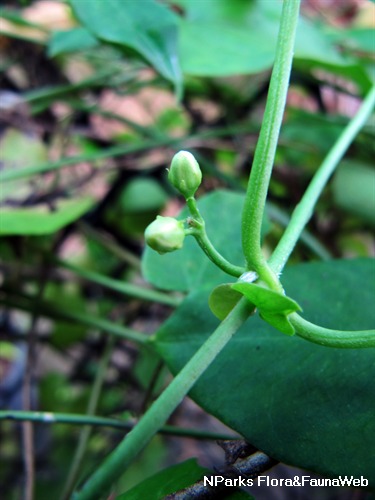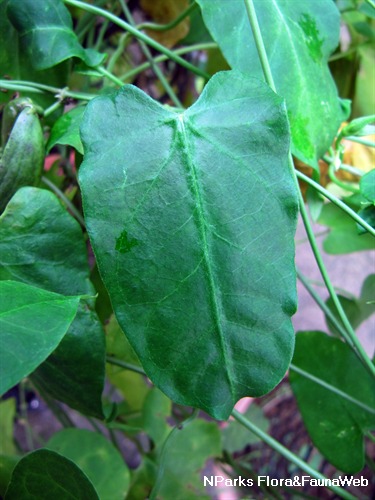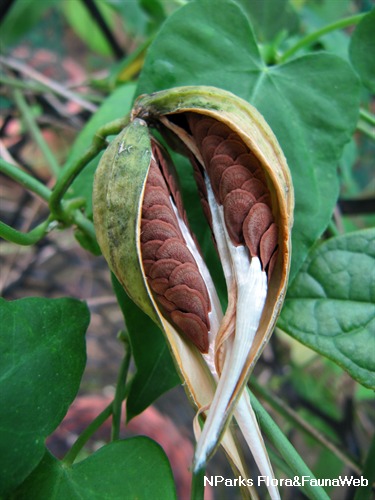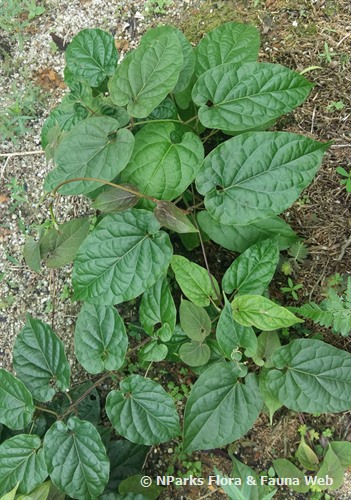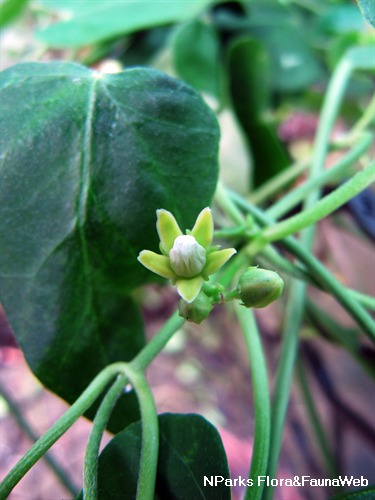
Back
Cynanchum tunicatum (Retz.) Alston
| Family Name: | Apocynaceae |
| Synonyms: | Periploca tunicata Retz. |
| Common Name: | Dog Strangling Vine |
Cynanchum tunicatum or Dog Strangling Vine is a slender climber recently naturalised in Singapore. It has narrowly egg-shaped to lance-shaped leaves with a heart-shaped base. Flowers are greenish yellow surrounded by greenish red lobes while the fruit is a spindle-shaped follicle usually paired, splits upon maturity. The Dog Strangling Vine is also a host plant for the Common Tiger butterfly (Danaus genutia genutia).
Name
Classifications and Characteristics
| Plant Division | Angiosperms (Flowering Seed Plants) (Dicotyledon) |
|---|---|
| Plant Growth Form | Climber |
| Maximum Height | 5 m |
Biogeography
| Native Distribution | India, Sri Lanka |
|---|---|
| Native Habitat | Terrestrial |
| Preferred Climate Zone | Tropical |
| Local Conservation Status | Non-native (Spontaneous (Naturalised)) |
Description and Ethnobotany
| Growth Form | It is a slender climber with white latex present in all vegetative parts, stems are twinning or pendulous up to 5 m long |
|---|---|
| Foliage | Leaves are narrowly egg-shaped to lance-shaped with a heart-shaped base measuring 3 - 15 cm long by 2 - 7 cm wide. Young leaves may have hairs on the upper surface. |
| Flowers | Flowers are held on an inflorescence, bearing 1 - 3 flowers at the axillary, measuring 4 - 15 mm long, 0.5 1 mm wide. The flowers are yellowish green outside, with 5 greenish red lobes. |
| Fruit | The fruit is a spindle-shaped follicle that splits upon maturity, usually paired, measuring 4 - 7 cm by 0.5 - 0.8 cm wide. Seeds are oval-shaped, flat bearing soft tufts of hairs. |
| Habitat | It occurs in dry deciduous forest, disturbed habitats such as construction sites and along sandy shores. |
| Associated Fauna | It is the caterpillar food plant for the Common Tiger (Danaus genutia genutia). |
| Cultivation | It can be propagated by seeds. |
| Etymology | The genus, Cynanchum is made up of the Greek words, cyno- meaning dog, -anchum meaning to strangle thus giving the common name, Dog Strangling Vine. |
Landscaping Features
| Desirable Plant Features | Ornamental Flowers |
|---|---|
| Thematic Landscaping | Butterfly Garden |
| Usage Hazard - Cons | Irritant - Sap |
Fauna, Pollination and Dispersal
| Fauna Pollination Dispersal Associated Fauna | Butterfly Host Plant (, Leaves) |
|---|---|
| Pollination Method(s) | Biotic (Fauna) |
Plant Care and Propagation
| Light Preference | Semi-Shade |
|---|---|
| Water Preference | Moderate Water |
| Plant Growth Rate | Fast |
| Rootzone Tolerance | Easy to Grow, Fertile Loamy Soils, Moist Soils, Well-Drained Soils |
| Propagation Method | Seed, Stem Cutting |
Foliar
| Foliage Retention | Evergreen |
|---|---|
| Mature Foliage Colour(s) | Green |
| Foliar Type | Simple / Unifoliate |
| Foliar Arrangement Along Stem | Opposite |
| Foliar Attachment to Stem | Petiolate |
| Foliar Shape(s) | Non-Palm Foliage (Lanceolate, Ovate) |
| Foliar Venation | Pinnate / Net |
| Foliar Margin | Entire |
| Foliar Apex - Tip | Acuminate, Apiculate |
| Foliar Base | Cordate |
Non - Foliar and Storage
| Stem Type & Modification | Herbaceous |
|---|---|
| Root Type | Underground (Tap Root) |
Floral (Angiosperm)
| Flower & Plant Sexuality | Bisexual Flowers , Bisexual Flowers |
| Flower Colour(s) | Green, Yellow / Golden |
|---|
| Flower Grouping | Cluster / Inflorescence |
| Flower Location | Axillary |
| Flower Symmetry | Radial |
| Inflorescence Type | Raceme |
| Flowering Habit | Polycarpic |
Fruit, Seed and Spore
| Mature Fruit Colour(s) | Brown |
|---|---|
| Fruit Classification | Simple Fruit |
| Fruit Type | Dehiscent Dry Fruit , Follicle |
References
| References | Middleton, D.J. & Rodda, M. (2019). Apocynaceae. Flora of Singapore, vol. 13. Singapore: Singapore Botanic Gardens, National Parks Board. Royal Botanic Gardens, Kew (continuously updated). Plants of the World Online | Kew Science. https://powo.science.kew.org/taxon/urn:lsid:ipni.org:names:96650-1. Accessed 03 November 2022. |
|---|
Image Repository
Others
| Master ID | 34276 |
|---|---|
| Species ID | 8689 |
| Flora Disclaimer | The information in this website has been compiled from reliable sources, such as reference works on medicinal plants. It is not a substitute for medical advice or treatment and NParks does not purport to provide any medical advice. Readers should always consult his/her physician before using or consuming a plant for medicinal purposes. |

